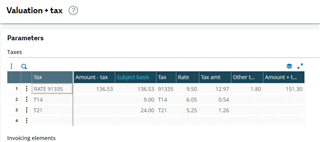Ok X3 Tax experts. This one is for you! There are now several states that are beginning to charge Alcohol Volume Taxes. The Tax determination rule function appears to be the perfect solution for the following: ABV Tax = Volume * Rate. In addition, the volume tax can have ranges. Example: ABV >=14% is one tax, and, ABV <=21% another. The volume is calculated and is retained in (among others) SINVOICED fields DSPVOU and DSPLINVOL. The tax rate is managed in the tax rate function, as designed. The challenge is when you are attempting to create a formula in the Tax Determination, the only table available is TAXLINK, and, the volume fields are not an option. What is the table TAXLINK used for? Other tables are not visibly an option.
I'm open to suggestions, as the volume tax is one with many variables. The Tax Determination function looks like the perfect solution, however, I can't figure this one out! Any help would be greatly appreciated.
Thanks!
Tom


